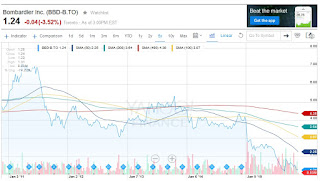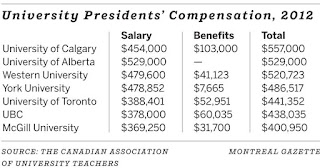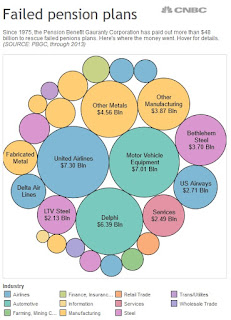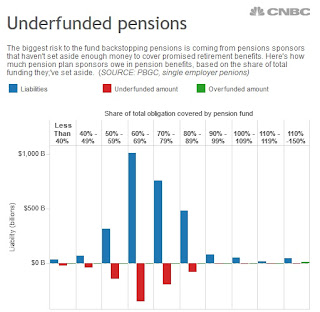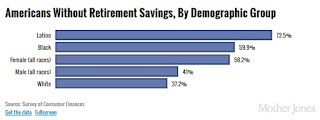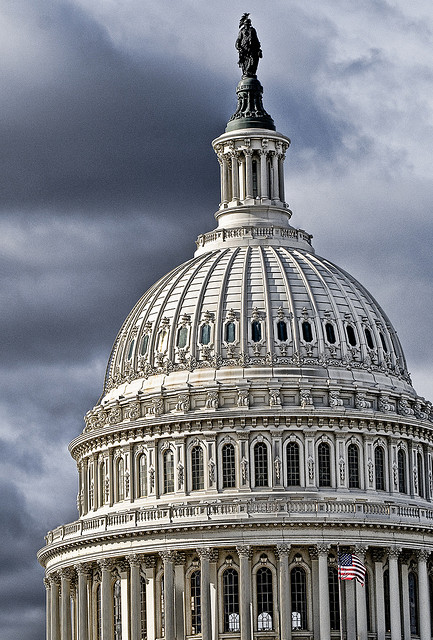Leo Kolivakis is a blogger, trader and independent senior pension and investment analyst. This post was originally published at Pension Pulse.
CBC News reports, Caisse putting $1.5B US into Bombardier for stake in rail business:
Bombardier has signed a deal that will see the Caisse de dépôt et placement du Québec (CDPQ) invest $1.5 billion US in a newly created company that will hold the company’s rail transportation business.
The giant Quebec pension fund — Canada’s second-largest — says the investment will help stabilize the company’s current financial situation.
The Caisse says it’s betting on Bombardier and in rail transportation.
The $1.5 billion represents a 30 per cent stake in a new holding company, BT Holdco.
The company is a subsidiary of Bombardier Transportation and will be based in Germany.The investment comes less than a month after the provincial government announced a bailout of more than $1.3 billion in the company’s struggling CSeries jet program. Bombardier posted a loss of $4.9 billion US in the third quarter.
Rail industry has ‘growth potential’
The Montreal-based company says the deal concludes its review of financing options for Bombardier Transportation, which sells subway cars and other mass transit systems.
“This investment by CDPQ, which has a long history as one of our major investors, is a testimonial to the growth potential of the rail industry and to Bombardier’s leadership in seizing the opportunities this market offers on a global scale,” Bombardier chief executive Alain Bellemare said in a statement.
Caisse president Michael Sabia said the investment is a safe bet.
“Bombardier Transportation is a global leader in the rail industry, with a robust backlog, predictable revenues, and meaningful potential for growth,” Sabia said in a statement.
Karl Moore, an associate professor at McGill University, said it’s a solid business deal, with more upside than Quebec’s investment in Bombardier’s CSeries program.
“It’s a different part of the business. As Michael Sabia points out, it’s a global business. It’s relatively resilient during tough economic times because it’s about government spending on rail companies, long-term infrastructure projects,” he said in an interview with CBC’s The Exchange.He said protecting Quebec industry is less a consideration than getting good return for the pension fund that the Caisse invests.
“They’ve structured it in a way that they will get very good returns in a safe manner,” he said.
Vanessa Lu of the Toronto Star also reports, Quebec pension fund buys $1.5B stake in Bombardier rail:
After a global search for an investor in its rail division, in the end Bombardier Inc. stayed close to home, turning to Quebec’s biggest pension fund for a $1.5 billion (U.S.) cash infusion.
In exchange for the money, the Caisse de dépôts et placement du Quebec gets a say in board members as well as the promise of at least 9.5 per cent annual returns for its 30 per cent stake in a new holding company known as BT Holdco.
If Bombardier Transportation doesn’t deliver, then the Caisse can increase its stake to as much as 42.5 per cent over the next five years. If the company delivers better returns, then the Caisse can reduce its stake.
Caisse CEO Michael Sabia touted the arrangement, which values the company at $5 billion (U.S.), as giving its depositors “bond-like” protection but with the “up side” of equity.
Bombardier has the option to buy out the Caisse at the end of three years, with guaranteed returns of a minimum 15 per cent, on an annual compound basis.
Sabia called that 15 per cent rate very attractive, but said he hopes the pension fund isn’t bought out that point.
“We think the transportation business has a lot of interesting potential,” said Sabia during a conference call on Thursday. “Bombardier Transportation is already a global champion. I think it can be an even bigger and stronger one.”That’s especially true because of demand in emerging markets like Asia and Latin America, he added.
“Obviously, there’s still a lot of work to do. That’s no secret,” Sabia said.Bombardier’s Class B shares, which are down almost 70 per cent year to date, closed unchanged on Thursday at $1.28.
The Toronto Transit Commission is furious with Bombardier over its long-delayed streetcar order, first placed in 2009. To date, the TTC only has 11 streetcars, with another en route from Thunder Bay.
Originally, 73 were supposed be in use by the end of 2015, but the schedule was revised to 20, which Bombardier says will only be 16.
In December, the TTC is expected to file a notice of complaint, seeking $50 million in damages over the delay.
The investment by Caisse comes on the heels of a $1 billion (U.S.) commitment from the Quebec government for a 49.5 per cent stake in Bombardier’s struggling CSeries program.
Development of the CSeries program is years behind schedule and billions over budget, but the flight testing is now complete. The company expects certification soon.
However, sales for the all-new plane, in two sizes, have been sluggish with only 243 firm orders to date – and none in a year.Porter Airlines, which has placed a conditional order for 12 planes, and options for another 18, will not be allowed to fly the jets from Toronto’s island airport, now that the Liberals have taken power in Ottawa.
As Bombardier has burned through cash to get the CSeries launched, it has had to make substantial job cuts and shelved plans for the Learjet85. Earlier this year, Bombardier raised $3 billion (U.S.) through a debt and equity offering.
With the Quebec investment and the deal with Caisse, which is scheduled to close in the first quarter of 2016, Bombardier estimates it will have access to $6 billion (U.S.) in cash and cash equivalents by year’s end.As a condition of the Caisse deal, Bombardier must ensure there is always $1.25 billion (U.S.) in liquidity. Sabia said the Caisse never considered investing in the CSeries program, choosing instead in the train division.
Bombardier’s CEO Alain Bellemare, who took over from Pierre Beaudoin in February, says the company has plenty of cash to complete all its programs including the CSeries jet and new Global 7000/8000 business jets.
It also provides a cushion in case market conditions prove difficult, Bellemare told reporters on Thursday. “We now have ‘a safety net,’” he said. “We will also re-establish confidence with our clients which is key if we want to continue selling our products.”
On the third-quarter conference call in October, Bellemare said an additional $2 billion (U.S.) investment would be needed for the CSeries program in the coming years, given it is not expected to get to profitability before 2020 or 2021.
While Quebec has called on the federal government to join in with a cash infusion, the new Liberal government hasn’t acted yet.
Bellemare said the company is continuing talks with the federal government for assistance, declining to offer any details.
It’s only a matter of time before the federal government matches the $1 billion (U.S.) the Quebec government invested in Bombardier.
What do I think about Bombardier getting billions from the provincial and federal government at a time when Quebec’s public school teachers are striking against austerity and demanding much deserved salary increases? It makes me cringe especially since I know the company has been poorly managed over the last few years as its upper management made all sorts of terrible decisions, all of which are reflected in Bombardier’s sagging stock price (click on image):
But the company is too important to Quebec’s economy to let it fall by the wayside and I’m not talking only about direct jobs. I’m also talking about a lot of small and medium sized enterprises that rely on Bombardier’s ongoing operations.
Still, one thing I would like to emphasize is not to look at the Caisse’s investment in Bombardier Transportation as an extension of the Quebec government’s decision to invest in the struggling CSeries program.
First, Bombardier Transportation has problems but it’s a growing business with great potential in developed and emerging markets. Second, the Caisse isn’t stupid. It structured the deal to ensure a guaranteed return and if it doesn’t get it, it will increase its stake in the growing transportation division. Third, the deal is structured in a way to ringfence it from the troubled CSeries program.
All this to say, when we want to help a giant Quebec corporation, we’re better off going through the Caisse than some government agency which doesn’t have return and risk in mind when handing out corporate welfare checks to poorly managed companies.
Photo by Renaud CHODKOWSKI via Flickr CC License

